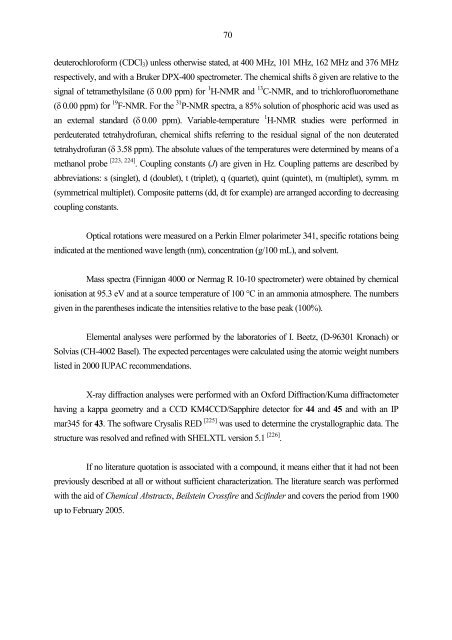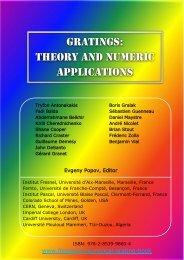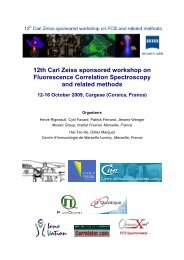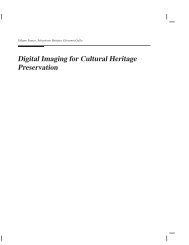My PhD dissertation - Institut Fresnel
My PhD dissertation - Institut Fresnel
My PhD dissertation - Institut Fresnel
Create successful ePaper yourself
Turn your PDF publications into a flip-book with our unique Google optimized e-Paper software.
70<br />
deuterochloroform (CDCl3) unless otherwise stated, at 400 MHz, 101 MHz, 162 MHz and 376 MHz<br />
respectively, and with a Bruker DPX-400 spectrometer. The chemical shifts δ given are relative to the<br />
signal of tetramethylsilane (δ 0.00 ppm) for 1 H-NMR and 13 C-NMR, and to trichlorofluoromethane<br />
(δ 0.00 ppm) for 19 F-NMR. For the 31 P-NMR spectra, a 85% solution of phosphoric acid was used as<br />
an external standard (δ 0.00 ppm). Variable-temperature 1 H-NMR studies were performed in<br />
perdeuterated tetrahydrofuran, chemical shifts referring to the residual signal of the non deuterated<br />
tetrahydrofuran (δ 3.58 ppm). The absolute values of the temperatures were determined by means of a<br />
methanol probe<br />
[ , ] 223 224 . Coupling constants (J) are given in Hz. Coupling patterns are described by<br />
abbreviations: s (singlet), d (doublet), t (triplet), q (quartet), quint (quintet), m (multiplet), symm. m<br />
(symmetrical multiplet). Composite patterns (dd, dt for example) are arranged according to decreasing<br />
coupling constants.<br />
Optical rotations were measured on a Perkin Elmer polarimeter 341, specific rotations being<br />
indicated at the mentioned wave length (nm), concentration (g/100 mL), and solvent.<br />
Mass spectra (Finnigan 4000 or Nermag R 10-10 spectrometer) were obtained by chemical<br />
ionisation at 95.3 eV and at a source temperature of 100 °C in an ammonia atmosphere. The numbers<br />
given in the parentheses indicate the intensities relative to the base peak (100%).<br />
Elemental analyses were performed by the laboratories of I. Beetz, (D-96301 Kronach) or<br />
Solvias (CH-4002 Basel). The expected percentages were calculated using the atomic weight numbers<br />
listed in 2000 IUPAC recommendations.<br />
X-ray diffraction analyses were performed with an Oxford Diffraction/Kuma diffractometer<br />
having a kappa geometry and a CCD KM4CCD/Sapphire detector for 44 and 45 and with an IP<br />
mar345 for 43. The software Crysalis RED<br />
[ ]<br />
structure was resolved and refined with SHELXTL version 5.1 226 .<br />
[ ] 225 was used to determine the crystallographic data. The<br />
If no literature quotation is associated with a compound, it means either that it had not been<br />
previously described at all or without sufficient characterization. The literature search was performed<br />
with the aid of Chemical Abstracts, Beilstein Crossfire and Scifinder and covers the period from 1900<br />
up to February 2005.













